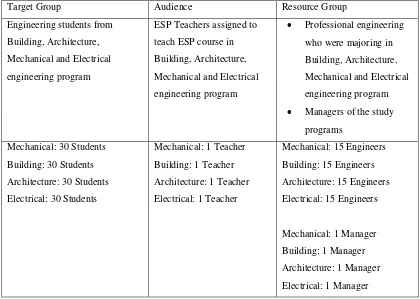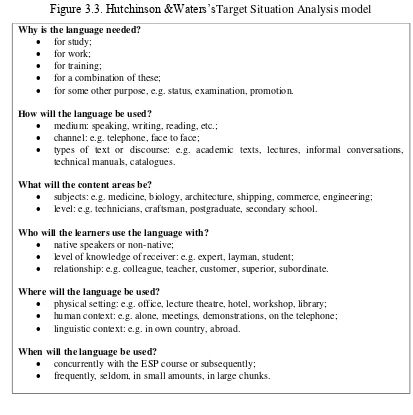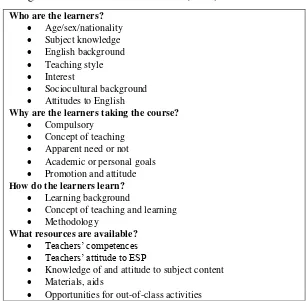CHAPTER III
RESEARCH METHOD
3.1. Introduction
This chapter discusses the methodology employed in this study. Firstly, the main purpose and the research questions (RQs) of the study are provided. Secondly, the mixed methods employed for this study and the rationale of the choice of these methods will be described. The next section involves a discussion of the research study in which the research context is outlined,
the participants involved in this study are detailed, and the researcher’s roles are explained. This
way, the current study is able to provide the clear map on addressing the target students’ needs as
students and their long-term needs as professional both from stakeholders’ perspectives. Next, the research instruments applied in the study are presented. These include questionnaires and interviews. The chapter, then, discusses the data analysis methods applied in the study, triangulation, the validity and credibility and some ethics and risks issues related to the study. Finally, the limitations of research methodology are discussed and conclusions are drawn.
3.2. Purpose of the Study and Research Questions
This study aimed to capture the English needs perceived by the target community in Indonesia engineering enterprise. The main objective of this study was to investigate why, where, when and how the target language was needed by the stakeholders through the use of
Hutchinson and Waters’s NA approaches (1987) of Present Situation Analysis (PSA) and Target
Situation Analysis (TSA). Thus, by investigating both English needs of engineering students and professionals, this study was able to capture the profile of English Engineering (EG) in Indonesia. Through a needs analysis using questionnaires and interviews eliciting the subjective perceptions of these populations, the study pursued the following objectives:
2. To produce a model of ESP data-driven syllabus which is suitable for the mentioned context
It was highly expected that this study would help to foster further understanding of
engineering students’ current and future English language needs from a pedagogical perspective
in Indonesian setting. Moreover, it was also expected to explore and indentifying learners’
specific needs as a necessary starting point in designing or developing courses, programs and curricula (Munby, 1978; Hull, 2006). Furthermore, in order to fulfill the mentioned objectives, this study generated the following research questions:
1. What are the specific English needs of Indonesian Engineering students and professionals to fully function in their academic and target career situation?
2. What type of syllabus is expected to meet the needs of engineering students in the mentioned context?
3.3. Research methods
Looking at the above research objectives, this study adopted a descriptive method. This type of research method is targeted to provide the description and interpretation of the data as it is (Cohen, Manion & Morrison, 2007, p. 205). The use of this methodology was expected to produce a fuller picture of the topic being investigated as well as expanding the scope and breadth of the “lacks, necessities and wants” (Hutchinson & Waters, 1987) of ESP learners, alumni/professional, teachers and course coordinators in their journey of fulfilling the
industrywide practice’s demands. The mentioned research design is married with the mentioned
study purposes as it “focuses on collecting, organizing and summarizing information” (Malik &
Hamied, 2014) obtained from the respondents of the Needs Analysis. Moreover, this study corresponds to the characteristic of descriptive research explained by Malik and Hamied (2014)
as it “describes” what the needs of Engineering community are like and how they are “related to each other” when they are simplified and synthesized in the form of a syllabus.
3.4. Setting and Respondents of the Study
Long (2005) who emphasized that the Needs Analysis should involve the target group, the audience, the needs analyst and the resource group. As informed by Brown (2009) the target group is the group, commonly students, where the information will be ultimately gathered. He further explains that the audiences (teachers, administrators) are those who will act upon the analysis. The needs analyst is the person to conduct the needs analysis and gain information from the other three groups. Lastly, the resource group is those who provide information on the target group (professors of content course of the students).
For the present study, the target group was represented by the engineering students from four majors; Mechanical, Building, Architecture and Electrical engineering, whereas, the audience was represented by the English instructors and finally the resource group was represented by the professional engineers and the managers of program study. Moreover, in drawing the population, this study employed stratified random sampling technique (Fraenkell & Wallen, 2008; Coolidge, 2000; Ivankova & Creswell, 2009). The similar sampling technique was also applied to the selection of graduates/professionals. The complete picture of the sample is drawn, as follows:
1. Engineering Students
The students from four-non-education-engineering majors were chosen to provide information on wants or subjective needs. The sample of the present study was 120 students majoring in non-education Electrical, Building, Architecture and Mechanical engineering at Indonesia University of Education, Bandung.
2. Professional Engineers
Information from professional engineers represented necessities or required knowledge. Sixty of them were chosen as respondents for the present study. These respondents were invited from a number of companies practicing in Building, Mechanical, Architecture and Electrical engineering. They were chosen due to the fact that they have experienced the target situation in industrywide practice. Thus, they possessed ideas of the target situation and suitable activities for the ESP course.
3. ESP Teachers
4. Study Program Managers
The faculty members provided information on the necessities or required knowledge. The present study involved four study program managers from four engineering study programs at UPI Bandung.
Figure 3.1. Respondents of Needs Analysis
Target Group Audience Resource Group
Engineering students from
In order to gain information and data needed in conducting the research, a questionnaire and interviews were conducted. A questionnaire was employed as a survey instrument to dig information from the respondents (Shavelson, 2002, p. 102). Meanwhile, interview was conducted to further investigate or gather more detailed and better information from the interviewee (Polkinghome, 2005; Miles and Huberman, 1994; DiCicco-Bloom & Crabtree, 2006). Details about the procedure of data collection are described in the following table:
Instrument Data Source Sample Questionnaire Engineering students at
Indonesia University of
Interview ESP teachers from
four-mentioned study
The questionnaires were first distributed to the 120 non-education engineering students at Indonesia University of Education on the 16th of June 2015 and the last day of the distribution was on 25th of June 2015. The questionnaire consisted of a series of questions derived from the Present Situation Analysis model proposed by Hutchinson & Waters (1987). This model reflects three sections: personal information, English needs, and suggestions for future ESP course. The personal information section covers the participants experience in previous English studies, situation of English use, and proficiency in English. Meanwhile, the English needs section was divided into five sub-sections: language functions, listening skills, speaking skills, reading skills, and writing skills. Lastly, the suggestions for future ESP course section included preferences of students in terms of topic, activities, materials, instructor, time, and assessment for the future ESP course.
of questions derived from the Target Situation Analysis model developed by Hutchinson & Waters (1987).
Figure 3.3. Hutchinson &Waters’sTarget Situation Analysis model
Why is the language needed? for study;
for work; for training;
for a combination of these;
for some other purpose, e.g. status, examination, promotion.
How will the language be used?
medium: speaking, writing, reading, etc.; channel: e.g. telephone, face to face;
types of text or discourse: e.g. academic texts, lectures, informal conversations, technical manuals, catalogues.
What will the content areas be?
subjects: e.g. medicine, biology, architecture, shipping, commerce, engineering; level: e.g. technicians, craftsman, postgraduate, secondary school.
Who will the learners use the language with? native speakers or non-native;
level of knowledge of receiver: e.g. expert, layman, student;
relationship: e.g. colleague, teacher, customer, superior, subordinate.
Where will the language be used?
physical setting: e.g. office, lecture theatre, hotel, workshop, library; human context: e.g. alone, meetings, demonstrations, on the telephone; linguistic context: e.g. in own country, abroad.
When will the language be used?
concurrently with the ESP course or subsequently; frequently, seldom, in small amounts, in large chunks.
3.5.2. Conducting of interviews
The interview with the ESP teachers was conducted on the 16th, 22nd, 24th of June 2015. The objectives were to find information that was required to complete the framework of Target Situation Analysis as well as to triangulate information regarding Present Situation described by the students.
The interview with the four study program managers was conducted between 23rd and 29th of June 2015. The objectives were to identify: 1. The vision and mission of the ESP course, 2. The ESP teachers, 3. The facilities for the course, 4. The urgent English language needs of the students.
Meanwhile, the interview with one engineering student was conducted on the 23rd of June 2015. The interview with this student was projected to add extra information in interpreting the data obtained from questionnaire.
Finally, the interview with the alumni (professional engineer) was conducted on the 27th of June 2015. Similar with the objective of the interview held with one of engineering students, the interview with one of professional engineers was also targeted to provide additional information on the questionnaire results.
Figure 3.4.Hutchinson and Waters (1987) Model of PSA
Who are the learners?
Why are the learners taking the course? Compulsory
Concept of teaching and learning Methodology
What resources are available? Teachers’ competences
Teachers’ attitude to ESP
Knowledge of and attitude to subject content Materials, aids
When and where the ESP course take place? Pleasant, dull, noisy, cold, etc
Time of day, everyday/once a week f/P-time, concurrent with need or pre-need
3.6. Data analysis
Data analysis is one of the most important steps in research (Leech and Onwuegbuzie, 2007, p. 562). The interviews of the present study followed the seven steps of interview investigations proposed by Kvale (1996, p. 88) consisting of thematizing, designing, interviewing, transcribing, analyzing, verifying, and reporting. From the closed questionnaire,
the respondents’ personal information and suggestions for English courses were summed up.
Afterwards, the sum was divided by the number of respondents and multiplied by 100 which gave the percentage (%) of each item. After being put into percentage, the results were displayed, described, and interpreted.
Meanwhile, data concerning English needs were in the scale from 1 (least important) to 5 (most important) as illustrated below in table 3.2. The results of the participants’ needs in English were summed up and then divided by the number of respondents to gain the mean (x). The mean (x) helped indicate the students’ needs in English where a higher mean (x) indicates higher needs whereas a lower mean (x) indicates lower needs. Data from questionnaire concerning the English needs were then displayed, described, and interpreted. The
RensisLikert’s scale (as cited in Khaemkaw, 2009, p.28) employed in the present study is as follows:
Figure 3.5.RensisLikert’s scale Scale Needs
5 Most Important
4 Important
3 Moderate
2 Slightly important
3.7. Validity
The present study employs triangulation by collaborating two data collection methods to triangulate results, p. interview and questionnaire. This is in line with Denzin (as cited in Flick, 2002, p. 226) and Oliver-Hoyo& Allen (2006) that triangulation involves the employment of multiple data collection methods. Furthermore, triangulation is important in improving the inflexibility of an analysis (Guba, 1985). Another validity test conducted in the present study is members check. According to Alwasilah (2012, p. 178), members check is conducted to avoid misinterpretation that a researcher makes. In addition, it helps establish the accuracy of the findings (Ivankova & Cresswell, 2009, p. 191).
Furthermore, to ensure the validity of the questionnaire, the researcher asked for feedback, critics, comments, and suggestions. According to Alwasilah (2009, p.176), feedback, critics, comments, and suggestions are required to identify threats towards validity. All the inputs gave contribution in designing the questionnaire for the research. The input for the present study was received from a senior lecturer of the English department at UPI who was the expert of EFL curriculum enterprise, ten engineering students and a number of doctorate researches.
3.8. Credibility
a. Triangulation
Triangulation is a technique in collecting and analyzing the data which are derived from multiple data sources aiming to minimize bias on data presentation of the study (Alwasilah, 2012, p.130). In this study, the particular strategy was used to enhance the data credibility by collaborating multiple data sources from interviews and questionnaire. Therefore, rich data in data collection and analysis could be beneficial in assuring a high quality conclusion.
b. Iterative questioning.
Iterative question is among the credibility assurance techniques involving the use of probes to elicit detailed data in which the researcher returns to matters previously raised by an informant and extracts related data through rephrased questions (Shenton, 2004, p. 65). Further it is stated that through iterative questioning falsehoods can be detected and the researcher may decide to discard the suspected data (Shenton (2004). Thus, this study included redirecting the same question in different forms to check the contradiction that occurred in each and every interview session held with the respondents.
c. Member Checks, Feedbacks, and Audit
Member check plays very important role to minimize missed-interpretation of behaviors, answers, and perspectives of the respondents (Alwasillah, 2012, p. 132). While feedbacks and audit are useful to gain various point of views from debriefer as peer examination or review toward the study. In order to enhance data credibility, the researcher will review the findings to the respondents, the supervisor, and debriefer in order to get valuable feedbacks for the study (Alwasillah, 2012, p. 132). Thus, this study employed this technique to ensure that what the respondent had said in the interview session was the exact perspective he/she believed.
3.9. Transferability
a) The number of organizations taking part in the study and where they are based; b) Any restrictions in the type of people who contributed data;
c) The number of participants involved in the fieldwork; d) The data collection methods that were employed; e) The number and length of the data collection sessions; f) The time period over which the data was collected.
3.10. Dependability
Similar with the term reliability in quantitative research, dependability is projected to
provide a “prototype model” to which other researcher then can follow (Shenton, 2004).
Therefore, as suggested by Shenton (2004), this study also provided detail information regarding
a) The research design and its implementation, describing what was planned and executed on a strategic level;
b) The operational detail of data gathering, addressing the minutiae of what was done in the field;
c) Reflective appraisal of the project, evaluating the effectiveness of the process of inquiry undertaken.
3.11. Ethical considerations
Prior to the commencement of the study, permission to conduct the research was obtained from Indonesia University of Education and from respondents themselves. The voluntary nature of participation was made as explicit as possible to the target learners, professional engineers, ESP teachers and the study program managers through the process of informed consent. Moreover, during the interview, they were not required to answer any questions they found
3.12. Conclusion
This chapter has discussed the methodology of the present study. The chapter covered the method of the study, the participants of the study, data collection, data analysis, and the validity strategies. The present study employed a triangulation design taken from the mixmethods paradigm to describe the English needs of non-education engineering students. The participants of the research consisting of respondents from Building, Architecture, Electrical and Mechanical engineering study program that included 120 engineering students, 60 professional engineers, 4 assigned ESP teachers and four study program managers. For data analysis, the results of questionnaire were analyzed based on a Likert’s scale, meanwhile; data from interview were analyzed interpretively. To ensure the validity of the questionnaire, the present study employed feedback. Meanwhile, to ensure the validity of the answers of the respondents of interview, the


